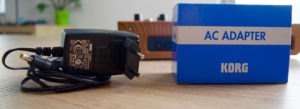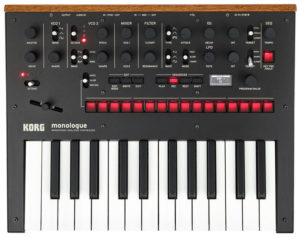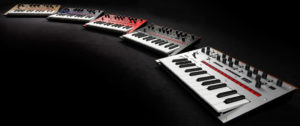The monologue, announced back in November 2016, is the latest compact analog monophonic Synthesizer from KORG. At first ridiculed as a simple monophonic version of the Minilogue, it quickly became clear that this is very own synth. Small, compact, analogue synthesis engine, advanced step sequencer, completely programmable, battery powered and affordable. Key features that aroused the interested of many electronic musicians.
Unboxing
The delivery scope of the KORG monologue can be described as very clear and spar. The device, some documents and three batteries. If you look for a power supply cable in the box, you are looking for in vain. KORG doesn’t include a power supply cable what is for me personal a critic because you must buy an additional one when you decide to buy a monologue.

So you must always see the price of the device including the additional power cable that cost around 33€ in Europe (KORG KA-350 Power Supply). If you don’t want to buy this cable, you can try to find a third-party cable or you must insert (re-chargeable) batteries in the monologue what is also not the best solution. I have re-checked this additional purchase with some other shops in Europe and I got always the confirmation that no cable is included. Some users contacted me that some stores outside of Europe, mostly in US include a power supply in the package. A bit strange but hopefully KORG can make this better in their future budget synths. It doesn’t cost a lot to include even in a budget synth for 299€/$.
Design & Build quality
In the design area, the monologue could chine from the first minute through the different available colours. It’s available in five different colours (gold, blue, red, black and silver) in which the device doesn’t look bad or ugly. All models come with the same design: black knobs and a front line in a wood look. Some buyers have slight problems with the wood optics which I personally like very much as it offers a good contrast to the different colours.
The layout of the 25-key mini key-bed is here compared to the other competitors in the same 300€ price class different. The key range goes from E to E what is quite unusual for small keyboard synths. Honestly, I was in the beginning very skeptical of the processing of the key-bed. I bought/received the monologue at end of 2016 and I must now confess that I like the layout very well. The keys have a solid quality and can be played very well. I’m not the best keyboard player but the keys, I like a lot even they are mini-keys. comparing this key-bed with this one from the Arturia Microbrute per example, I must confess that the monologue keys looks better and offers a better play surface. On top, they are also very useable as a midi keyboard on a computer.

About the processing of the device is nothing to complain after more than 6 months of testing. One of often assumes that instruments which deliver around 300€/$ comes with less quality. KORG has proven with their latest analog monophonic Synthesizer that synths for such a small price offer a very good processing quality. No failures to report after my long testing period. The device works still great, knobs have still the same grip and still looks like the first day. Looking at the backside where you find all necessary audio and midi connections of the monologue.
Backside

Starting on the absolute left side, where you have a DC coupled input and a power ON/OFF button. For using the monologue with the DC coupled input, you need a specific power supply with the right connector. You need to purchase an additional power supply with the correct connector because KORG unfortunately doesn’t include a cable in the box. (KORG KA-350 Power Supply) You receive 6 standard AA batteries but no cable. Than you have USB Port that allows users to transfer and backing up patches to/from the internal memory (limitation of 100 patches). KORG offers here a free editor for PC/Mac that simply the patch transfer. The USB port is also designed for using the monologue as MIDI keyboard on your PC & Mac. Next you have a standard MIDI In/Output interface as well as two connections for sync in/out as known from other KORG instruments and controllers. Important to mention here is that KORG doesn’t build a MIDI thru connection here but only a MIDI output.
Further you have an audio input where you can route any audio source to the monologue engine. Per example. you can route a signal from another Synthesizer directly to the filter or amp section. For this specific topic, I created some months ago a video where I use the audio input feature to manipulate the initial sound character of the monologue.
On the absolute right side, you have also an classical mono audio output and a stereo headphone connection. The headphone output is here super handy if you use per example the device with batteries outside your studio environment.



1 Trackback / Pingback